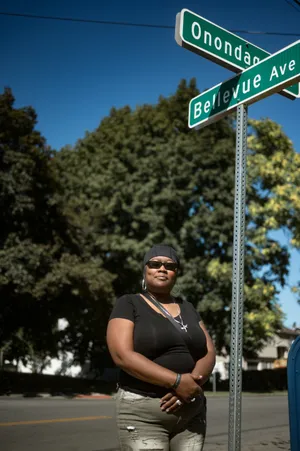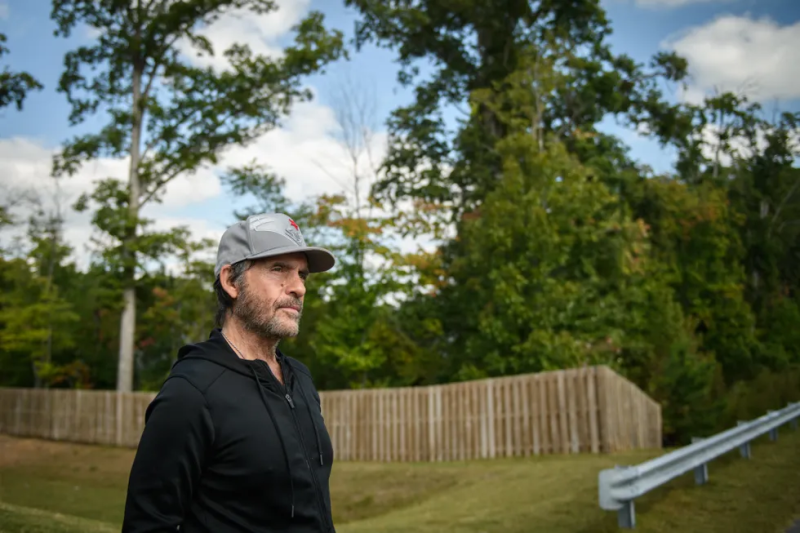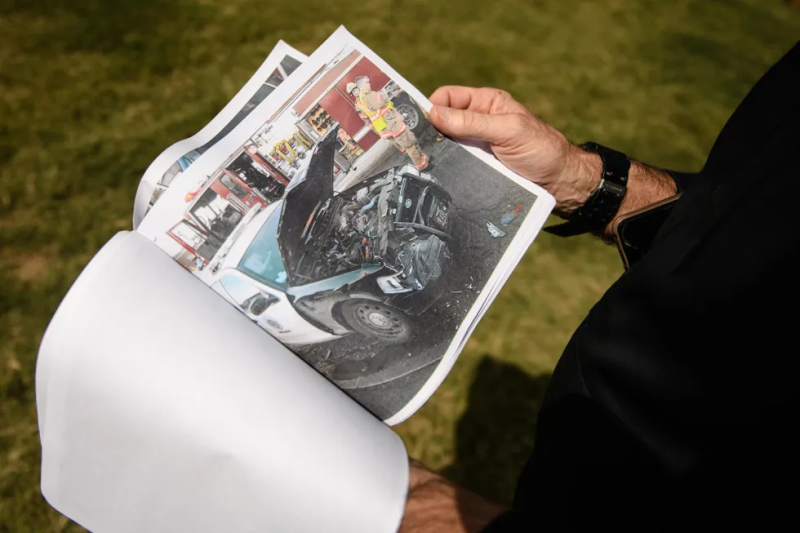Devastating injuries. Sometimes few consequences. How frequent police crashes wreck lives.
Deshane Levere was counting the blocks before she could make it home to bed. It was a summer night at 3 a.m. She'd been at a family gathering and was a designated driver.
Now, with her stepdaughters and another passenger safely aboard, she hit the gas at a green light in Syracuse, New York.
Three blocks from home, she thought.
Out of nowhere, a police cruiser hurtled down the avenue, despite the red light commanding traffic to stop. The police officer slammed into Levere's four-door sedan, ripping off her rear bumper and sending her car careening.
Why didn't she see or hear the cruiser coming? The police officer had not turned on his lights and sirens, she would later learn.
Searing pain enflamed her neck and spine. These were the first moments of the agony that would haunt her over the next decade — spreading through her back, her shoulder, her arms. Neither pain medications nor strenuous physical therapy would give her much relief.
Standing at the same intersection last summer, 10 years into a recovery that never happened, Levere's eyes welled with tears.
Memories flooded back from a losing court battle here in this city of about 150,000 in upstate New York. Her lawsuit against police was tossed on appeal, leaving her with little recourse to offset the cost of life-altering back pain.
The police department and justice system, said the 52-year-old Black woman, seemed designed to protect the officer who caused the crash. It didn't seem concerned about helping innocent victims. “It’s like police can do whatever they want and get away with it,” Levere said, “and I’m still here picking up the pieces.”
Hers was one of many other lives that have been shattered by police officer crashes in hamlets and cities across the country. The crashes are part of a national public safety crisis that is only now coming into sharper focus through deep reporting in the USA TODAY Network project called "Driving Force."
Officers face few consequences for wrecks
For "Driving Force," USA TODAY's New York newsrooms partnered with Syracuse University and The Central Current to investigate for the first time a 10-year span of these crashes across New York. Our early data analysis from one sample city — Syracuse — shows that from 2013 to 2022, hundreds of collisions involving law enforcement vehicles exacted a heavy human and societal toll.
Officers faced little or no discipline after many of those wrecks, some of which left victims permanently injured.
Training shortfallJust 3% of NY police training is devoted to emergency driving skills

Journalists spent months interviewing dozens of crash victims, collision reconstruction experts, attorneys and driving instructors for this revelatory investigation. They analyzed thousands of pages of court records and data on police crashes, particularly pertaining to the Syracuse Police Department, our most complete set of information from one city so far. We found:
- Police officers with track records of unsafe driving sometimes just stay behind the wheel, despite piling up crashes that devastate the lives of civilans.
- Penalties that officers face for driving recklessly are sometimes connected solely to how much they have damaged police vehicles. Have they also damaged civilians, not just cop cars? That question is limited or ignored altogether.
- Police departments handle most investigations of their own officers’ crashes, raising conflict of interest concerns and questions about officers who faced no discipline.
- In contrast, civilians must prove police acted with “reckless disregard” for safety to overcome broad legal immunity that shields emergency responders. The steep state legal standard helps police avoid crash lawsuits, win appeals or push to limit settlements.
- Thousands of police officers need more emergency response driving training — both in academies and on the job. But we found that driver training standards in a state like New York can lag national trends. Instead, state officials are beefing up weapons training.
Put simply, police lack accountability and victims face massive barriers to justice.
Buried in hundreds of pages of investigation reports and police data are crucial details about what causes law enforcement crashes in America, as well as keys to curbing the destruction.
The documents and data showed hundreds of police-involved crashes in one city seemingly boiled down to everyday careless driving mistakes. Take the officer who took his eyes off the road to dig through a bag before rear-ending another driver at a red light.
The findings underscore the stark reality that many police officers across the country view assertive driving as a necessary risk in their line of work, federal research shows.
“It isn’t always cops driving fast because they’re on some power trip,” said Hope Tiesman, a research epidemiologist at the National Institute for Occupational Safety and Health.
Scores of other crashes touched on everything from policing technology in vehicles to training officers receive to drive safer during emergency responses. They included the most dangerous collisions during high-speed pursuits or at intersections when officers run red lights.
Many of those law enforcement-related crashes spotlighted the fact their jobs, at times, can require split-second life-and-death decisions.
Lifting the veil of police secrecy
We continue to fight for release of crash records in other communities, trying to lift the veil of secrecy covering thousands of police vehicle collisions.
The stakes couldn’t be higher, said Adam Hyde, vice chairman of the international Accreditation Commission for Traffic Accident Reconstruction. Flawed investigations could wrongly send a driver to prison for decades, or unnecessarily cost local governments millions of your taxpayer dollars in court.
The transparency problem can't be ignored, said Hyde, who also is part of a reconstruction team overseeing officer-involved crashes in the Chicago area.
“At the end of the day, whether the officer is the victim, or the other driver is: They have the right to understand what happened,” he said.
The real cost of police crashes

Charles McLoughlin has been reeling since a Syracuse police officer slammed his cruiser into McLoughlin's work van in 2013. For a living, he drove patients to doctor appointments. But the neck injury from the crash made it impossible for him to turn his head for simple things, like checking blindspots in traffic.
It meant he would never again be able to renew his commercial driver’s license. It cost him his livelihood.
A court battle over the crash dragged on for nearly a decade. At one point, McLoughlin sold his house due to growing medical bills and legal fees, leaving his native Syracuse to relocate to North Carolina.
In the end, what McLoughlin described as pre-trial legal tricks — including the city hiring a high-powered outside legal firm that uncovered new event data recorder, or black-box, evidence — led him to take just a $49,500 settlement.
After paying legal fees, the 72-year-old grandfather was left with about $27,000 and a mountain of debt.
“I’m stuck with a bad neck for the rest of my life,” he said. “And once I paid everyone off, I ended up with almost nothing.”
Are police investigating police?
The USA TODAY Network-Syracuse University team explored conflict of interest concerns by analyzing a dozen lawsuits filed against police, revealing the fullest picture yet of how one city investigated crashes and handled resulting civil lawsuits.
In at least six cases, witnesses and victims disputed police accounts of crashes, including claims about speed and use of emergency lights or sirens. Outside experts hired by two victims, including McLoughlin, also asserted some of the police department’s crash reports and collision reconstructions contained flaws.
“At best,” one expert wrote, the police crash investigation was “cursory and incomplete.”
Another expert declared the police produced “an insufficient report to prove cause or fault” in a crash that left a bicyclist with a traumatic brain injury, which contributed to the city agreeing to pay out a $700,000 settlement.
‘Change is slow’
Scattershot efforts to reduce police crashes in the past decade have only made halting progress across the country. Some cities have limited high-speed police pursuits to violent felonies or other serious crimes, but similar statewide efforts in Washington and New Jersey derailed in the face of police union pushback and rising auto thefts.
At the same time, revelations are mounting about thousands of innocent bystanders killed nationally during high-speed police chases, as well as skyrocketing costs of legal settlements. The havoc wreaked by crashes is made all the more devastating as SUVs become the new standard for patrol vehicles.

The resulting carnage is distressing: About 52,000 Americans were injured in crashes involving law enforcement vehicles in pursuit from 2017 to 2021, the most recent federal data show, while fatal police pursuits cost nearly 2,400 lives.
Those statistics get even grimmer considering evidence-based solutions for reducing police crashes exist, such as a federally backed program that reduced Las Vegas police crashes by 14% and injuries by 31%.
“Change is slow and just because you build it doesn’t mean they come,” said Tiesman, the federal expert who spearheaded the Vegas turnaround that included speed caps, mandatory post-academy driver training, new pursuit policies and other officer education.
This story is part of Driving Force, a police accountability project meant to expose and document the prevalence of police vehicle accidents in New York.
This joint investigation between USA TODAY Network-New York and Syracuse University’s S.I. Newhouse School of Public Communications was supported with funding from the Data-Driven Reporting Project. That project is funded by the Google News Initiative in partnership with Northwestern University-Medill.
This reporting was completed in partnership with The Central Current, a Syracuse-based nonprofit newsroom.
Disclaimer: The copyright of this article belongs to the original author. Reposting this article is solely for the purpose of information dissemination and does not constitute any investment advice. If there is any infringement, please contact us immediately. We will make corrections or deletions as necessary. Thank you.



